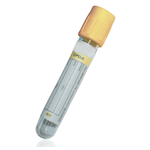Suitable Specimen Types
- Serum
Sample Processing in Laboratory
Usual
Sample Preparation
Centrifuge
Turnaround Time
1 daySample Stability
Serum or plasma treated with heparin or EDTA may be used. Samples should be clot-free and free of red blood cells or other particulate matter.
The presence of fibrin may cause erroneous results. If testing is delayed, store at 2-8˚C for up to 14 days. For longer periods, store serum frozen at -20˚C.
Follicle Stimulating Hormone (FSH)
General Information
Follicle Stimulating Hormone (FSH), like Luteinising Hormone (LH), belongs to the gonadotropin family. They synergistically regulate and stimulate the growth and function of the ovaries and testes.
FSH and LH are released in pulses from the gonadotrophic cells of the anterior pituitary. The levels of circulating hormones are controlled via negative feedback to the hypothalamus. Increased concentrations of the gonadotrophins are seen in ovarian failure in women, whether pathological or after the natural menopause.
High concentrations of FSH are seen in azoospermic men and LH is increased if testosterone secretion is decreased.
Patient Preparation
Samples from patients receiving high biotin doses (i.e. >5 mg/day) should be taken at least 8 hours post dose. Please inform the laboratory if the patient has been treated with monoclonal mouse antibodies or may have received them for diagnostic purposes.
Notes
None Given
Reference Range
FSH:
- 0.95 – 11.95 IU/L Males
- 3.03 – 8.08 IU/L Female: Follicular phase
- 1.38 – 5.47 IU/L Luteal phase
- 2.55 – 16.69 IU/L Female: at ovulation
- 26.72 – 133.41 IU/L post menopausal
(Source: Abbott Diagnostics)
Specifications
- EQA Scheme?: Yes
-
EQA Status:
NEQAS and WEQAS
